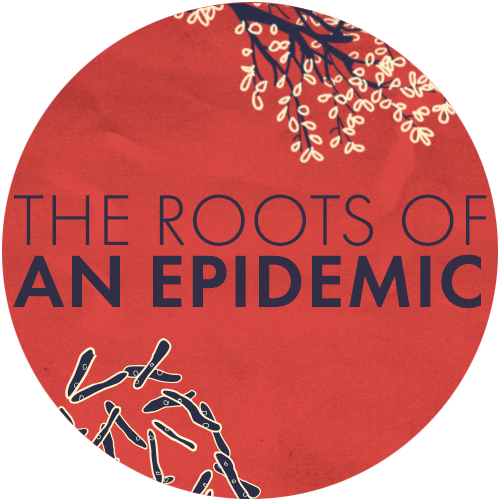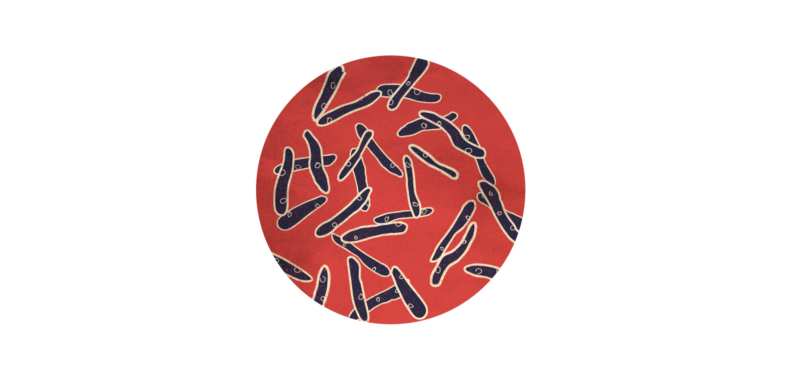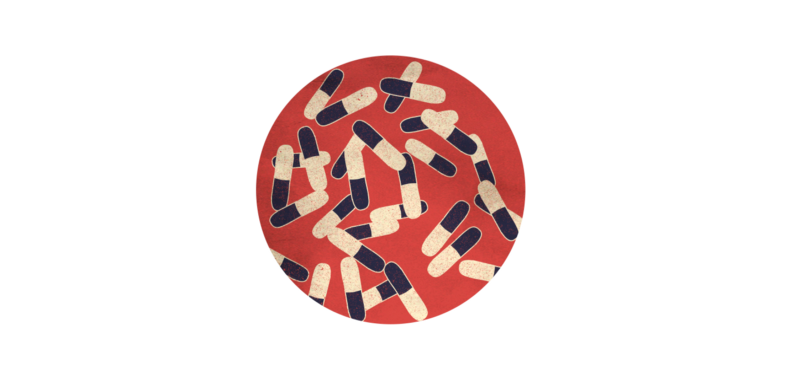

Read the next installment: “The Gendered Realities of the Tuberculosis Epidemic“
Read the previous installment: “The Exploitative History of One of the World’s Deadliest Diseases“

Like several of the great medical breakthroughs of the 20th century, the cornerstone of modern tuberculosis treatment owes as much to science as it does to serendipity: in the 1950s, three pharmaceutical companies unwittingly found themselves at the center of an extraordinary coincidence.
At the start of the 19th century, tuberculosis, or TB, was one of the leading causes of death in Europe and the United States. But by the the first half of the 20th century, the devastating rates of prevalence and mortality had been declining for several decades, partly due to a drive to sequester all TB patients in sanatoria, where they received ample bed rest, exposure to sunlight and fresh air, and healthy nutrition. Patients were still dying from TB, but the 1882 discovery of the microorganism that caused the disease had finally allowed for targeted research to find a cure. In the 1940s, two medicines with antituberculous effects were identified, but high rates of drug resistance and relapse in patients treated with these drugs led to a continued quest to develop new treatments.
It was around this time that the three pharmaceutical companies–Squibb (now Bristol-Myers Squibb) and Roche, both in New Jersey, and Bayer, across the ocean in Germany–simultaneously “discovered” isoniazid. Although each manufacturer was in pursuit of a different drug target, routine testing of the intermediate compounds formed in the process led them to stumble across something unexpected: a compound that showed a level of antitubercular activity scientists had never seen before, and that had more tolerable side effects than other available TB treatments.
For months, the companies kept their discoveries secret, pending clinical trials to determine efficacy. The Roche trial at Sea View Hospital, on New York’s Staten Island, was the first to break the good news. In 1951, the hospital had begun testing isoniazid on its sickest patients , in a program overseen by Doctor Edward H. Robitzek. “They were destined to die,” Robitzek later recalled, according to a 2003 New York Times retrospective. “If we said we wanted to give them arsenic, they would have taken it.” But isoniazid brought them back from their deathbeds, and, the Times report says, “when reporters converged on Sea View in February 1952, they discovered ecstatic patients. One woman told The New York Times that she considered the drug “‘the most wonderful thing in the world.”’
To the three companies, however, the most wonderful thing in the world suddenly raised the prospect of a legal battle over who owned the patent rights, as they had all discovered the exact same drug at the exact same time. And then came another remarkable plot twist: a thorough literature search revealed that isoniazid had in fact been discovered in 1912 by two PhD students in Prague. Its anti-TB properties hadn’t been identified at the time, and the compound was not thought to be of much medical relevance, so the discovery’s publication in a medical journal had received little attention.
“It lay undiscovered like a time-bomb, for the earlier synthesis meant that isoniazid could not be patented,” writes Walter Gratzer in his book First Do No Harm. “Had the publication by the two students come to light sooner, no pharmaceutical company would have considered embarking on a research programme based on the compound, and humanity might have been deprived forever of a life-saving medicine.”
But, thanks to the manufacturers’ mistaken assumption that there was a patent incentive for this research, TB care was transformed forever.

Nearly seven decades later, patent rights were at the center of an unexpected furor in the lead-up to the United Nations’ first high-level meeting (HLM) on TB. In July, 2018, when the UN released the text of the official declaration that heads of state would endorse at the event, groups working on TB around the world expressed alarm over the conspicuous lack of language on the need for TB-related TRIPS flexibilities–life-saving loopholes to the international patent rules outlined by the Agreement on Trade-Related Aspects of Intellectual Property Rights.
TRIPS flexibilities are based on the principle that the right to health overrides the right to profit; they allow for the use of generic medicines to respond to public health emergencies in countries that cannot afford more expensive patent-protected brands. Between 2001 and 2016, these flexibilities were used by over 80 countries around the world to treat a variety of diseases. It is due to TRIPS flexibilities that the lowest available annual per-patient cost of HIV medicine has been reduced more than a hundredfold over the past 15 years. The absence of an explicit commitment to these flexibilities in the HLM declaration could mean new TB drugs are locked into patents that render them unaffordable for most patients.
In response, the South African government took the rare step of issuing a last-minute objection during the short window granted for UN member states to accept a declaration after it has been circulated. South Africa, which has one of the highest burdens of TB in the world, said, “As it currently stands, the draft outcome of the first UN High-Level Meeting on TB falls well short of providing millions of our fellow human beings, who are dying from this preventable, treatable and curable disease, with affordable access to the medicines they so desperately need.”
The need for better TB medicines is indeed desperate. In the decade following the isoniazid breakthrough, a few more anti-TB compounds were discovered. This gave rise to a four-drug regimen that is still used today. Two of those medications–isoniazid and rifampicin–are the main components of the six-month treatment course. As treatment was scaled up in the second half of the 20th century, prevalence and mortality rates further declined–and complacency set in. Research dwindled, and even though TB remained a problem in parts of the world, it fell off the radar of global health priorities.

In the late 1980s and 1990s, however, the epidemic reemerged on a global scale, fueled in large part by the rise of HIV. Concern about this resurgence was compounded by the startling outbreak of multidrug-resistant TB (MDR TB) in New York. MDR TB–which is resistant to both isoniazid and rifampicin, requiring more lengthy, complex, and expensive treatment with different drugs–triggered widespread alarm that TB was not only persisting but evolving against the drugs that should have ended it. In the absence of research on new antituberculous compounds, the health care community was forced to combat MDR TB by dusting off drugs that had long been shelved due to their toxicities and difficult dosing regimens.
In rhetoric, at least, TB was now recognized as an urgent priority–but the pace of the global response didn’t reflect this urgency. The case for increased investment was–and continues to be–further complicated by the fact that the epidemic was concentrated in the world’s poorest populations, which didn’t offer an attractive “market” to a biomedical industry that viewed health care as a lucrative commodity rather than a common good. Although it was acknowledged that drug-resistant tuberculosis–DR TB, a category that includes MDR TB as well as TB that is resistant to any type or number of medications–was a man-made and preventable crisis, the epidemic continued to escalate. In 2006, South Africa became the site of the first documented outbreak of extensively drug-resistant tuberculosis, or XDR TB.
XDR TB was found to be resistant even to the back-up drugs that had been identified for treatment of MDR TB, and more than half of the patients diagnosed with it had not previously received TB treatment. Although the emergence of resistance had initially been attributed to patients not completing their treatment courses as prescribed, it was now clear that direct airborne transmission of DR TB from one person to another was taking place.
In a time of increasing international mobility, this development soon led to the recognition of TB as a global security threat. In 2007, an American MDR TB patient travelled through Europe for his honeymoon then took multiple flights back to North America, potentially exposing everyone along his journey to infection. While such exposure is a daily risk in countries with endemic TB, its occurrence in more privileged settings made headlines, driving home the message that TB anywhere is TB everywhere.

Today, the World Health Organization (WHO) estimates that the continued funding gap for TB research is more than one billion U.S. dollars. But over the past 10 years there have been more advancements in new TB drugs and diagnostics than were seen in the previous 40. In addition to private pharma and biotech companies, government agencies have made immense contributions to research–especially in the U.S., which also exerted extreme pressure to ensure that TRIPS flexibilities were dropped from the UN’s HLM declaration. Research has also been driven by nonprofit entities like the Gates Foundation, which, as one of the largest investors in TB research, has played a key role in fomenting arranged marriages between public sector needs and private sector interests.
For the first time since the 1960s, two new medicines are available, offering unprecedented hope to patients with XDR TB, for which death rates as high as 73% have been reported. Earlier this year, Johnson & Johnson agreed to sell bedaquiline, the more widely used of the two drugs, at a reduced price of $400 per treatment course in countries that need it most–although research suggests that a fraction of this price tag would still yield healthy profits for the company. When factoring in the additional medicines needed for a complete treatment regimen, the lowest price for a full course of XDR TB treatment currently totals well over $2,000, a hefty fee for what’s widely referred to as “a disease of poverty.”
Following South Africa’s objections, the text of the HLM declaration has undergone revisions as its authors aim to find a middle ground. The final language endorsed at the HLM this week will help to determine whether bedaquiline and other new drugs in the pipeline can offer a new wave of hope–as isoniazid did almost 70 years ago–or whether they will end up as solutions locked in glass cabinets, inaccessible to those who most need them but can least afford them.

But the challenge won’t end there. New technologies, while desperately needed and long overdue, aren’t enough in and of themselves. This is evident in the case of the GeneXpert TB test, one of the most significant developments in the TB response over the past few years. The test uses molecular technology, which is more accurate and much faster than the microscopy that has been used for decades. Instead of the minimum of two days needed for a result from microscopy, Xpert needs less than two hours, during which it can also detect drug resistance–a diagnosis that takes several weeks using conventional lab culture methods.
Given that timely diagnosis of TB patients is a top priority–and a major stumbling block–for effective public health responses, Xpert was heralded as a game changer for TB control. Its 2010 endorsement by WHO was followed by a pooled-purchase commitment from U.S. government agencies, the health care initiative UNITAID, and the Gates Foundation, guaranteeing a minimum number of sales for the company at a price reduction. Still, the cost remained high for under-resourced TB programs, raising concerns that weak health systems were not sufficiently primed for rapid expansion of this new technology. Nonetheless, supporters emphasized the programmatic benefits, and Xpert was swiftly rolled out with the backing of major donors, including the Global Fund, which cofinanced the diagnostic and pushed countries applying for grants to ensure that it was included in their proposals.
But in the years that followed, assessments of Xpert’s real-world impact began to deflate the hype. To this day, uptake and utilization remain lower than expected in many countries. A 2018 study from Gates Open Research on the market penetration of Xpert in high-burden countries found that, despite a tendency toward increased access to Xpert, all the countries studied reported underutilizing the technology they had purchased. An earlier study had found that over 60% of HIV-TB treatment sites surveyed in 18 countries had Xpert available, but it had been used for less than 5% of the patients who should have received an Xpert test according to clinical guidelines.
These disappointing findings offer important lessons for the global TB response. They underscore the need for more comprehensive interventions, according to Soumya Swaminathan, deputy director-general of WHO and former head of India’s National Institute for Research on TB. “To have impact on the disease as a whole, we need to pay attention to each step in the cascade,” she says. “So it is not enough to improve the diagnosis or detection of disease without paying attention to optimal treatment, adherence support, and community engagement.”
Such approaches require a deeper, more complex understanding of the health systems and the broader context in which interventions are designed and implemented. Khairunisa Suleiman, a biochemist who has been involved in assessments of the tool’s rollout in public sector systems of several African countries, says that “GeneXpert was not designed to suit low-income countries,” citing incompatibilities between the conditions (both environmental and infrastructural) required for the device to function well and the realities on the ground. But it’s more attractive to focus on technologies in isolation, she reasons, because “people want to bite off what they can chew, and they feel that strengthening health systems is too big–then we end up shooting ourselves in the foot.”

Suleiman’s perspective is reflected in studies on the implementation of Xpert, which have highlighted broader challenges facing the frameworks in which the system is used, such as inconsistent power supply and faulty generators, lack of cooling systems needed to operate the equipment, or poor training and supervision programs for the staff tasked with operating the technology. While the innovative diagnostic no doubt improved care in settings where it was successfully used, most notably by reducing time to TB treatment, research indicates that, overall, it hasn’t had a significant impact on TB mortality.
In an editorial for the British Medical Journal, TB researchers Madhukar Pai, Samuel G. Schumacher, and Seye Abimbola cite Xpert as an example of the tendency of global health responses to fixate on technologies without taking into account the broader challenges. Given that many steps of the care cascade are weak in high-burden settings, they ask, “Is it fair to expect a TB test to save lives?”
The editorial calls for a shift from fixations on tools to patient-centered solutions. This advice seems intuitive, given how evident the broader gaps in health systems are. So why, I ask Madhukar Pai, does a fixation on tools persist? “It is complex,” Pai says. “But I think [it] is driven by broader trends (e.g., widespread availability of mobile phones), [a] push by donors that come from the tech world (e.g., Gates Foundation, Chan Zuckerberg Initiative), desire for quick impact, and because addressing weak health systems requires serious investments, long-term vision, and patience.” He continues, “It is much easier to scale up a vaccine, for example, than address underinvestment in primary care by many countries. So the global health community is constantly looking for silver bullets to overcome the weak health systems we find in many low-income countries.”
Global conversations on TB do recognize the importance of strengthening health systems. Though the recently-issued Charter for Advancing Innovation to End TB focused largely on technologies, it highlights the need for long-term commitments to building the capacity of health systems. Soumya Swaminathan, the deputy director-general of WHO, emphasises that, “The ultimate control and elimination of TB as a public health problem will need attention to both upstream determinants (nutrition, pollution, poverty etc) and the better implementation of existing tools and strategies, through stronger health systems.” The WHO’s annual global TB report includes sections dedicated to reporting on universal health coverage and social determinants, and explicitly recognises that global TB goals will only be met if TB services are delivered in the context of progress on these broader fronts.
Ensuring that adequate attention is given to these priorities, however, requires thinking–and acting–far beyond the disease-specific realm of TB. The factors governing investments in strengthening countries’ health care systems are incredibly complex, stretching across finance, infrastructure, education, and many other sectors. They are influenced by geopolitical hierarchies. They bring up murky questions around “governance and accountability,” whose answers differ from place to place. They lead us, once again, to the conclusion that global health problems need political solutions.

Read the next installment: “The Gendered Realities of the Tuberculosis Epidemic“
Read the previous installment: “The Exploitative History of One of the World’s Deadliest Diseases“

How We Get To Next was a magazine that explored the future of science, technology, and culture from 2014 to 2019. The Roots of an Epidemic is a four-part series on tuberculosis, the leading cause of death from an infectious agent around the world.
